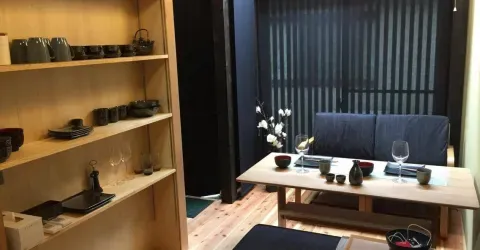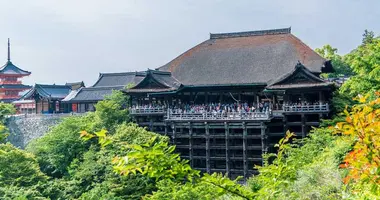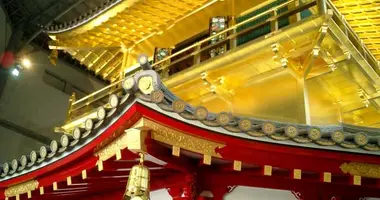Kawaramachi Catholic Church: A Spiritual Landmark in Kyoto
Nestled in the heart of Kyoto, the Kawaramachi Catholic Church stands as a testament to faith and resilience. Also known as St. Francis Xavier Cathedral, this spiritual haven has been serving the Catholic community since 1890. The church's history is deeply intertwined with Japan's complex relationship with Christianity, making it not just a place of worship but a symbol of perseverance. With its unique blend of Western architecture and Japanese influences, the cathedral offers visitors a glimpse into the rich tapestry of Kyoto's religious heritage. From its marble interiors to its stunning stained glass windows, every element of the church tells a story of devotion and cultural fusion.
History and significance of Kawaramachi Catholic Church
The roots of Kawaramachi Catholic Church trace back to the Meiji Period, a time of significant change in Japan. In 1890, Friar Villon, a missionary from the Paris Mission Society, constructed the first church on this site. This came after the lifting of the edict that had banned Christianity in Japan, marking a new era of religious freedom.
However, the church's journey was far from smooth. In 1967, the original wooden Baroque-style structure was carefully dismantled and moved to Meiji Mura in Inuyama, Aichi Prefecture, where it stands today as a National Cultural asset. This relocation made way for the construction of the current modern cathedral, designed by Swiss missionary Friar Freuler.
The church's significance extends beyond its architectural evolution. It serves as the cathedral for the diocese encompassing Kyoto, Nara, Shiga, and Mie prefectures, making it a central figure in the region's Catholic landscape. The cathedral's location in Kyoto, once the imperial capital and a city steeped in traditional Japanese culture, underscores the complex interplay between Eastern traditions and Western religious influences.
Architectural features and design elements
The current Kawaramachi Catholic Church, completed in 1967, is a marvel of modern architectural design with a nod to traditional Japanese aesthetics. Standing 43 meters long, 15.4 meters wide, and 24 meters high, the cathedral cuts an impressive figure on Kyoto's skyline.
One of the most striking features is the curving roof, which draws inspiration from traditional Japanese Shinto shrines. This architectural choice beautifully blends Western religious architecture with Japanese cultural elements, creating a unique visual harmony. The exterior of the church, with its clean lines and modern materials, stands in contrast to the ornate Baroque style of its predecessor.
Inside, the cathedral's design is both grand and intimate. The interior space is arranged with four rows of pews in width and twenty rows in length, capable of seating 440 people. This layout creates an inclusive atmosphere, allowing the congregation to feel connected during services. For those with hearing difficulties, the church thoughtfully provides a hearing aid system, ensuring that everyone can fully participate in the services.

Kawaramachi Catholic Church, Kyoto
Interior highlights and sacred spaces
Step inside Kawaramachi Catholic Church, and you'll find yourself surrounded by a harmonious blend of reverence and artistry. The interior is a testament to the church's commitment to both beauty and functionality in sacred spaces.
One of the most striking features is the extensive use of marble. The altar, lectern, sanctuary, and even the floor are all crafted from this elegant stone, creating a sense of timeless grandeur. The marble's cool, smooth surface reflects light in a way that seems to illuminate the space from within, enhancing the spiritual atmosphere.
The stained glass windows, created by Swiss artist Hans Stocker, are true masterpieces. As you enter, your eyes are drawn to the right side of the church, where these vibrant works of art tell stories of faith. The first window depicts the Archangel Michael, followed by an image of St. Francis Xavier, the church's patron saint. The subsequent windows illustrate the 14 Stations of the Cross, guiding visitors through Christ's journey.
Behind the altar, a large stained glass window depicting the Creation story serves as a breathtaking focal point. The arrangement of these windows is particularly noteworthy - they form the shape of the Japanese archipelago, with green and purple as the dominant colors, symbolizing vegetation growing in light and water. This artistic choice beautifully melds Christian iconography with a celebration of Japan's natural beauty.
At the rear of the cathedral, visitors will find a special space dedicated to the Christian martyrs of Nagasaki. This solemn area honors the 187 men, women, and children who died for their faith during the persecutions of the late Azuchi-Momoyama Period and early Edo Period. It serves as a poignant reminder of the sacrifices made by early Japanese Christians.
The story of "Our Lady of the Capital" statue
In the basement chapel of Kawaramachi Catholic Church lies a bronze statue with a remarkable history - "Our Lady of the Capital" or "Miyako no Seibo" in Japanese. This statue's journey to Kyoto is a tale of faith, perseverance, and international cooperation that spans over a century.
The story begins in 1847 with Father Leon Lobin, a priest in a small village in eastern France. Moved by accounts of Japanese martyrs, he initiated a "movement to pray for the restoration of the church in Japan." This local effort soon spread across France, capturing hearts and minds with its mission.
In 1865, inspired by the dream of St. Francis Xavier to build a church in Kyoto dedicated to the Holy Mother, Pope Pius IX commissioned the creation of six bronze Marian statues. These statues depicted Mary holding the infant Jesus, modeled after an image Xavier had brought to Japan. On December 31, 1865, the Pope blessed these statues, christening them "Holy Mother of the Capital."
One of these statues was destined for Kyoto, but Japan's strict anti-Christian laws at the time posed a significant challenge. In 1866, the statue was sent to Father Giral in Yokohama, along with instructions to bury it on a hill overlooking Kyoto. The hope was that this act would spiritually pave the way for missionaries to enter the city.
It wasn't until May 1873 that Father Vigourroux, accompanying a European diplomatic corps to Kyoto, finally managed to fulfill this wish. He buried the statue at Higashiyama Shogunzuka, a spot offering a panoramic view of Kyoto. This secret act of devotion remained hidden for years.
Finally, on September 28, 1879, Father Villion, who had come to Kyoto as a French teacher, unearthed the statue and brought it to a temporary chapel. When Kawaramachi Church was built in 1890, the statue found its permanent home, symbolizing the fulfillment of Xavier's centuries-old dream.
Today, this statue stands as a powerful reminder of the enduring faith of Catholics in Japan and the international solidarity that supported them through years of persecution. Visitors to the church can view this historic statue in the basement chapel, connecting with a tangible piece of Kyoto's Catholic history.

Kawaramachi Catholic Church, Kyoto
Visitor information and services
Kawaramachi Catholic Church welcomes visitors of all faiths, offering a glimpse into Kyoto's diverse religious landscape. Located in the heart of the city, the church is easily accessible and provides several services to enhance your visit.
To reach the church, take the Kyoto subway to Kyoto Shiyakusho station on the Karasuma Line. From there, it's a short walk south. Alternatively, you can take Kyoto buses #4, #5, #17, or #205, which stop near the church. The church's central location puts it within walking distance of other notable landmarks like the Kyoto City Halland Kyoto Hotel Okura.
Upon arrival, visitors will find a reception desk on the left side of the courtyard. The friendly staff are available to answer questions and provide guidance. For those requiring medical assistance, an AED machine is also available at the reception area.
The church offers various mass times to accommodate different schedules. Sunday masses are held at 7:00 AM and 10:30 AM in Japanese, with an English mass at 12:00 PM on the 2nd and 4th Sundays of each month. Weekday masses in Japanese are typically held at 6:30 AM and 6:30 PM, except on Thursdays. However, it's always best to check the official website for the most up-to-date schedule.
For those with mobility concerns, the church is equipped with an elevator between the main entrance stairs and the basement stairs, ensuring accessibility for all visitors. Whether you're coming for a mass, to admire the architecture, or to enjoy a moment of quiet reflection, Kawaramachi Catholic Church offers a welcoming environment in the midst of bustling Kyoto.
Religious services and community activities
Kawaramachi Catholic Church is more than just a beautiful building; it's a vibrant spiritual community at the heart of Kyoto's Catholic life. The church offers a range of religious services and community activities that cater to both local parishioners and visitors from around the world.
The regular mass schedule reflects the church's commitment to serving its diverse congregation. Sunday masses are held at 7:00 AM and 10:30 AM in Japanese, providing options for early risers and those who prefer a later start. Recognizing the international nature of Kyoto, the church also offers an English mass at 12:00 PM on the 2nd and 4th Sundays of each month, making it a welcoming space for English-speaking residents and tourists alike.
On weekdays, the church maintains a consistent schedule of morning and evening masses, typically at 6:30 AM and 6:30 PM. These services provide regular opportunities for prayer and reflection amidst busy work weeks. The basement chapel, with its intimate setting, is often used for these weekday masses, creating a more personal atmosphere for worship.
Beyond regular masses, Kawaramachi Catholic Church hosts a variety of community activities and special services throughout the year. These may include:
- Religious education classes for children and adults
- Preparation courses for sacraments such as Baptism, First Communion, and Confirmation
- Prayer groups and Bible study sessions
- Special masses and events during important liturgical seasons like Advent, Lent, and Easter
- Community outreach programs and charitable activities
The church also serves as a gathering place for Kyoto's Catholic community, hosting social events that foster a sense of belonging and mutual support. These activities not only strengthen the faith of the congregation but also provide opportunities for cultural exchange, given the diverse backgrounds of the church's members and visitors.
For those seeking spiritual guidance or wishing to participate more deeply in church life, the church staff and clergy are available for pastoral care and counseling. Whether you're a long-time parishioner or a visitor seeking a moment of peace in your travels, Kawaramachi Catholic Church offers a welcoming spiritual home in the heart of Kyoto.

Kawaramachi Catholic Church, Kyoto, showing the Rose Window
The church's role in Kyoto's Catholic heritage
Kawaramachi Catholic Church plays a pivotal role in preserving and promoting Kyoto's rich Catholic heritage. As the cathedral for a diocese that spans four prefectures - Kyoto, Nara, Shiga, and Mie - it stands as a beacon of faith in a region historically dominated by Buddhist and Shinto traditions.
The church's significance is deeply rooted in the complex history of Christianity in Japan. Following the arrival of St. Francis Xavier in 1549, Christianity spread rapidly in Japan, only to face severe persecution during the Hideyoshi Toyotomi and early Tokugawa periods. The establishment of Kawaramachi Church in 1890, after the lifting of the ban on Christianity, marked a new chapter in this tumultuous history.
Today, the church serves as a living link to this past, educating visitors about the struggles and triumphs of Japanese Catholics. The special space dedicated to the Nagasaki martyrs, for instance, offers a poignant reminder of the sacrifices made by early Japanese Christians. This connection to history makes Kawaramachi Church not just a place of worship, but also a site of historical and cultural significance.
Moreover, the church plays a crucial role in fostering interfaith dialogue and cultural exchange in Kyoto. Its presence in the heart of this ancient capital, known for its Buddhist temples and Shinto shrines, serves as a testament to Japan's growing religious diversity. The church often participates in local cultural events and initiatives, helping to bridge understanding between different faith communities.
For the Catholic community in Kyoto and beyond, Kawaramachi Church serves as a spiritual and administrative center. It coordinates various diocesan activities, supports smaller parishes in the region, and provides a gathering place for major Catholic celebrations and events. This central role ensures that the church remains at the heart of Catholic life in the area.
As Kyoto continues to evolve as a modern city while preserving its rich cultural heritage, Kawaramachi Catholic Church stands as a symbol of the city's religious diversity and openness to global influences. It invites visitors to explore another facet of Kyoto's spiritual landscape, complementing the city's renowned Buddhist and Shinto sites. Whether you're a practicing Catholic, a student of religious history, or simply a curious traveler, Kawaramachi Catholic Church offers a unique window into the enduring presence of Christianity in Japan's cultural capital.






























